"A man ought to read just as inclination leads him, for what he reads as a task will do him little good."—Samuel Johnson
| Reviews | Limericks | Six Words | Buy Nothing |
 29 December 2003
29 December 2003
Blankets: An Illustrated Novel
Craig Thompson
This graphic novel, the size and shape of a Dickens tome but every page covered in pictures, was the perfect companion for a recent snow day. It's the autobiographical story of Craig, a teenaged misfit from a Christian home who falls for Raina, another Christian teen and outsider. (Why are graphic novels always about misfits? There's plenty of textual literature and rock-and-roll about happy, well-adjusted people, but even superhero stories—graphic literature's staples—are about outcasts). The title is a metaphor several times over: it's the sheets Craig and his little brother made into a fort and a ship's sail when they shared a bed together as children; the snow covering northern Michigan when Craig and Raina get to spend several weeks together; the quilt she makes for him; maybe even the smothering lectures he gets in religion classes. The drawings are the swirly black and white etchings you'd likely see on the notebook of the long-haired quiet guy in the back row of homeroom; they depict the fresh excitements of childhood wonder and first love as they begin to fray, worn down by life's long winters and dashed dreams.
More graphic fiction: Summer Blonde
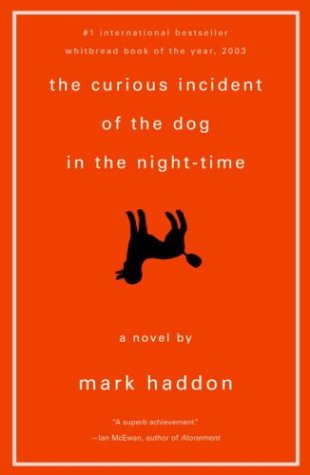 29 December 2003
29 December 2003
The Curious Incident of the Dog in the Night-Time
Mark Haddon
This slim novel entwines several mysteries: who killed Christopher's neighbor's dog, how Christopher will find the killer, and what he will do when he does. Christopher, aged fifteen, has Asperger's syndrome, which makes him equally annoying and endearing and very difficult to live with. The different foods on his plate can't touch each other, and can't be yellow or brown. He can't tell a lie. He can't read facial expressions. He knows everything about Apollo space missions. And if the careful order of his life is upset he "does groaning." Haddon's deadpan delivery in Christopher's voice is amusing when revealing the reactions adults have to Christopher and touching when it portrays what it's like to be inside his head. Yet we never pity Christopher. We root for him, we want to protect him, we wonder how many of those strangers we pass on the street might think like him, and we realize that we are all unreliable narrators.
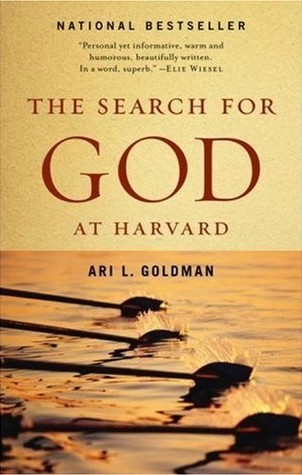 29 December 2003
29 December 2003
The Search for God at Harvard
Ari Goldman
Goldman took a sabbatical from the New York Times to spend a year at Harvard Divinity School. The author of Being Jewish, an accessible, intelligent, interesting, and very warm look at Judaism, Goldman is a good writer and great reporter. He has his own agenda here, however; the chapter titled "Hinduism," for example, offers a few paragraphs about Hinduism and several pages of Goldman's own observations of lesbian and gay divinity students. The main story he tells is of his determination to be simultaneously a successful Times reporter and an observant Orthodox Jew; he's the first person to attempt such a combination, and with luck and chutzpah he succeeds. This memoir is a little breezy, but if you don't come expecting to actually find God at Harvard you'll enjoy this look at the divinity school through the eyes of a smart observer and committed Jew.
Another book about a year at Harvard: One-L
 10 November 2003
10 November 2003
The Israelis: Ordinary People in an Extraordinary Land
Donna Rosenthal
This book is basically just a bunch of facts and anecdotes strung together, frequently as non-sequiturs and often weakly attributed. Rosenthal is a reporter and is largely impartial towards her contentious subject matter, but she writes like she's on a deadline. Still, this is an enticing overview of various aspects of Israeli social and cultural life, and a great source of background information on the country's various populations. It's a reminder that Israel is not all Jews, and the Jews are not all alike. Israelis are Arab Muslims; Russian Christians; Mizrahi Jews who flooded into Israel from Islamic countries; the Druze, who believe in reincarnation and are noted for their faithful military service; the nomadic Bedouin; Ethiopian Jews lifted from an isolated pre-industrial society into one of the most technologically advanced places on earth; and highly educated Ashkenazi Sabras, "natives" who immigrated in the last century. This young country with an ancient history is a palimpsest crowded with contradictions. Religion shapes public life, as the Orthodox require businesses to obey the laws of kashrut and control marriage and divorce, yet Israel has the world's most progressive gay rights laws. Most Israeli Jews are secular, and those who are not are Orthodox; there is only one Reform synagogue in Tel Aviv. Yet the Jewish calendar is the standard one, and secular Israeli Jews celebrate as a matter of course holidays that most in the diaspora have barely heard of. Rosenthal portrays the stress that defines Israeli life: the shudder of a nearby bomb blast, the wail of sirens, the panicked phone calls to check on the children who take the bus to school, how it feels to rush from a wedding to attend a funeral. She illustrates the tensions among various Israelis: the peaceful Arabs living under the suspicion of their Jewish neighbors; the Orthodox West Bank settlers living among Palestinians; the gradual resignation and defection of kibbutzniks to a capitalist economy; the secular resentment against the Orthodox who receive government support for their studies but exemption from military service; and the ultra-Orthodox who reject the government of Israel as a heresy, awaiting the government of the messiah, and who can't converse in modern Hebrew as they think God's tongue should only be used for Torah study. Rosenthal's book could have used a compelling narrative and a good editor, but it's easy to read and packed with information about a place that's like nowhere else in the world.
More about Israel: How to Understand Israel in 60 Days or Less
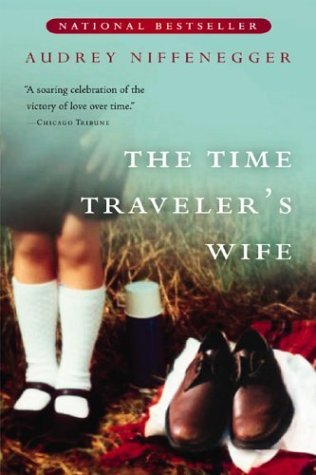 29 September 2003
29 September 2003
The Time Traveler's Wife
Audrey Niffenegger
I can't remember the last time I was so absorbed in and moved by a novel. Henry DeTamble, born in 1963, is the only known person with a genetic disorder that makes him a "chrono-displaced person." One moment he is at his job in a Chicago library, the next he is whipsawed through time, landing naked and hungry in a completely different place and time. He's often sent back to his past to revisit painful memories, but also has the chance to teach his young self the things he'll need to know to survive as a time-traveling adult and to meet his wife, Clare, an artist, when she's just a girl. When she meets him in real time, she's the one who already knows all he's told her about their future, but to him she's a stranger. This book is so carefully thought out and skillfully written that once you accept the premise of time travel and a the causal loop of a pre-determined world it all holds together remarkably well. As Henry and Clare's relationship builds in layers of time experienced in a different order by each of them, we wonder if time travel is just a physical expression of the power of memory, a weird and extreme manifestation of the out-of-syncness any couple has to learn to accommodate. Niffenegger even provides a plausible sounding biological cause for Henry's disorder, and has her characters discuss free will and determinism. For those who thrill to the mind-bending conundrums and little frissons one gets from time travel books, there's plenty here. But it's not all fun. Time is a force throwing Henry around, imprisoning him between his known future and the past he's doomed to relive. The book reads like a modern literary fairy tale; it's also science fiction, and, at its dark climax, a horror novel. There are flaws: the characters are a little flat and Clare and Henry's voices, which take turns narrating, are confusingly indistinguishable in their high-flown Rilke-quoting tone. And there are a couple of tiny inconsistencies spottable in the plot if one thinks about it very carefully. All completely forgivable, given the feat of imagination it took to create this marvel of a book. It's begging to become a movie.
More time travel: Kindred, Time and Again
Also by Niffenegger: Her Fearful Symmetry
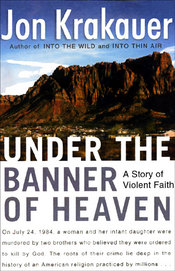 29 September 2003
29 September 2003
Under the Banner of Heaven: A Story of Violent Faith
Jon Krakauer
In 1984, Brenda Lafferty and her baby daughter were murdered by Brenda's husband's brothers, Ron and Dan, who claimed to be acting on instructions from God. Fundamentalist Mormons, the Lafferty brothers perceived the independent-minded Brenda Lafferty as a threat and, convinced of the divine inspiration of their actions, never expressed remorse for the murders. Krakauer has a great reputation, which he and his publisher capitalize on, transparently, with a book jacket featuring a big rock under blue sky and a weak attempt to draw an analogy between "extreme religion" and mountaineering. Unfortunately, even being centered on a grisly murder linked to a religion that once embraced polygamy and was started by a talking angel wasn't enough to bring this book to life. The profile of the Church of Latter Day Saints is getting higher all the time, not least because of the election of its members to public office. There are more than 11 million Mormons worldwide and their numbers are growing fast. Among the major world religions, Mormonism is by far the most recent, started long after the invention of the printing press and even after photography, and is the only American-grown faith. Krakauer stresses the distinction between fundamentalist Mormon sects and mainstream latter-day-saints who distance themselves from fundamentalism and polygamy, and between the squeaky clean students at Brigham Young University and the man who abducted Elizabeth Smart. He tells the remarkable story of how an evening spent listening to his brother preach "the word of God" abruptly transformed Ron Lafferty from admired family man to rabid, vengeful killer. But mostly he leads us on a long slog through the names and dates of Mormon history. Krakauer asks the pivotal question on page 294: "If Ron Lafferty were deemed mentally ill because he obeyed the voice of his God, isn't everyone who believes in God and seeks guidance through prayer mentally ill as well? This is, after all, a country led by a born-again Christian, George W. Bush, who believes he is an instrument of God and characterizes international relations as a biblical clash between forces of Good and Evil." Excellent point. Regardless of their beliefs, humans are responsible for their actions, and they must answer to the human laws of right and wrong.
Also by Krakauer: Into the Wild
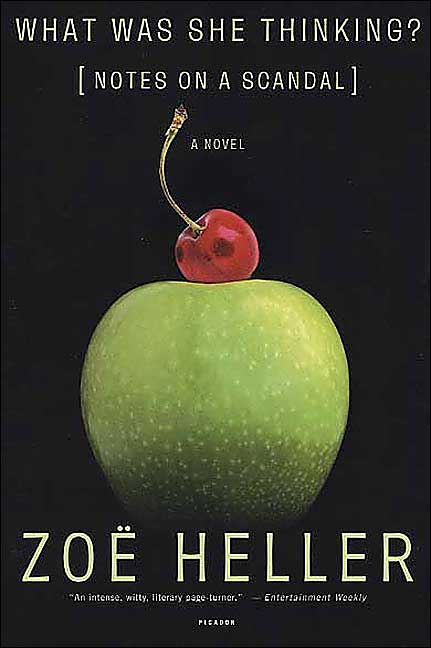 29 September 2003
29 September 2003
What Was She Thinking? Notes on a Scandal
Zöe Heller
The scandal is art teacher Sheba Hart's affair with a fifteen-year-old male student, but the heart of this story is Heller's artful and amusing portrayal of the dynamic of intimacy and competition in friendships among women. The novel has the perfect narrator in Barbara, an older teacher and a very solitary person. Her new friend Sheba is the most exciting thing to enter her life in years and commands her full attention. Barbara is able to coolly appraise others' motivations as well as her own; she is aware of her fundamental loneliness and her attempts to use her friendship with Sheba to slake it. This is a satire of academia and the media age and a comedy of middle class manners, yet the romance between teacher and student is realistic, down to grass in the hair and a spat over a crude comment. The novel's light feel is deceptive; as Barbara realizes that, despite her clumsy attempts at connection, she is ultimately alone, it's hard not to notice a lump in the throat.
Also by Heller: The Believers
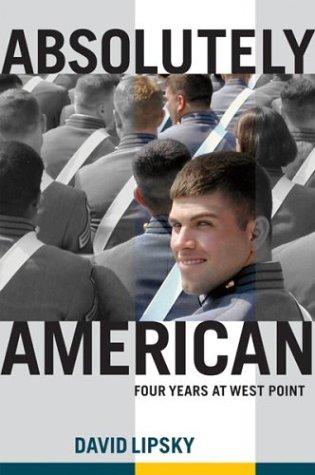 29 September 2003
29 September 2003
Absolutely American: Four Years at West Point
David Lipsky
Lipsky resisted his assignment from Rolling Stone to visit West Point and write an article. He ended up spending four years there and writing a book. For those of us who observe the military from afar with a mix of gratitude and unease, this book is an education. Lipsky follows a group of cadets through their four years at the academy in the late 1990s, as West Point, like many American institutions, grapples with seismic shifts. There is a practical problem: more and more cadets are going to West Point for an education, serving their time, and then leaving for the civilian world rather than making the military their careers. There is also an ideological struggle: on the one hand is the military tradition of a cohesive, all-male culture, on the other, women are enrolling in record numbers (while the number of black soldiers in the officer corps is nowhere near proportionate to their numbers in the military in general) and the political correctness of the culture at large is infiltrating the academy, speaking a completely foreign language and wreaking havoc. Given modern American culture, where leadership has come to mean either being the "most" (richest, best looking, coolest) or self-righteously browbeating with empty phrases like "family values," it's good to know that there's at least one place where integrity is the highest standard. Cadets learn to lead by example, and there is no compromising on honor, character, or honesty. Lipsky makes his admiration for the institution clear. He gets a little stuck (we seem to hear over and over about one plebe's struggles to run two miles in the required 15:54), but this is an eye-opening look at a world that to many is foreign, even while it is thoroughly American.
See also: Generation Kill
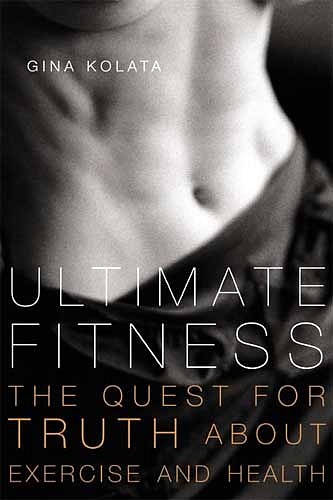 29 September 2003
29 September 2003
Ultimate Fitness: The Quest For Truth About Exercise and Health
Gina Kolata
New York Times reporter Kolata is obsessed with exercise, and she gives the impression that she's going to deliver the definite numbers
on such questions as how high a heart rate is needed to burn fat or how many lifting reps are required to build muscle. But, as we could have guessed,
results are inconclusive. Anyway, Kolata is more interested in waxing euphoric about the joys of spinning. It's not her fault
our bodies don't come with owner's manuals and we have to learn everything about exercise and health by trial and error.
There are some interesting anecdotes about this learning process; it's always good to be reminded that things were once very different,
that what we take for fact was once considered fallacy, and vice versa. Around the same time people thought that tomatoes were poisonous,
they thought that running would kill you. Even in the 1960s, a fitness author out for a jog was pulled over by the police because they thought he must be a fleeing criminal.
On the other hand, in the early twentieth century there were celebrated female weightlifters. Some good tidbits are here, but the best advice is still not enough to fill a book:
Eat your vegetables, move your body, and get enough rest. Now if I could only stop singing the author's name to the tune of a certain Rupert Holmes song...
More about exercise: Brother Iron, Sister Steel
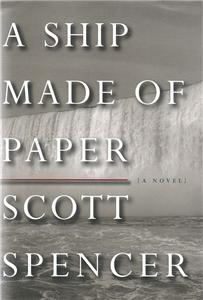 5 August 2003
5 August 2003
A Ship Made of Paper
Scott Spencer
Best known for the novel Endless Love, which inspired a silly movie and an exquisite pop song, Spencer is a much better writer than his pop-culture associations would indicate. In this new novel, Daniel Emerson is a trial lawyer whose life has been threatened by a gang of thugs in retaliation for his unsuccessful defense of their cohort. Daniel, who is white but has always had an affinity for black culture, suddenly finds himself living in fear of black people (his client, and his client's menacing friends, are black). He leaves his thriving practice in Manhattan to return to the small upstate New York town he grew up in. Back in his mostly white hometown, he promptly falls head over heels in love with Iris Davenport, a married black woman. Daniel lives with his girlfriend and her daughter and sees his standoffish parents occasionally—he's not quite a father, not quite a husband, and not quite an orphan, as his girlfriend observes—and he's also a hopeless romantic. He seems to think he's found the love of his life in this impossible relationship with Iris, and whether what he really wants is her or what she represents to him in the end doesn't really matter. Daniel's sappy heart and jerky knee on the subject of race are counterbalanced by his smart, no-nonsense girlfriend and by Iris's husband, a banker simmering with carefully controlled rage. One appalling thing after another happens, making the book hard to put down and not easy to forget.
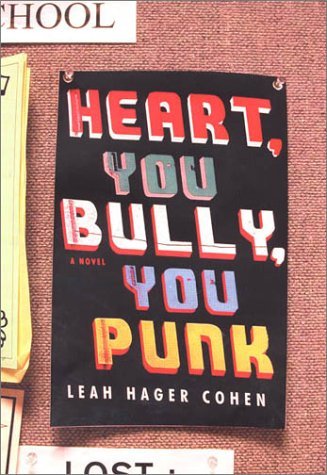 5 August 2003
5 August 2003
Heart, You Bully, You Punk
Leah Hager Cohen
I.J. Esker is a young math teacher at a tony private high school in Brooklyn. When one of her favorite students, Ann, mysteriously falls off the bleachers, Esker, as she calls herself, offers to tutor the girl at home. As she grows closer to Ann, whose mother left the family to pursue her acting career, Esker is also drawn to Ann's father, Wally, a kind and warm restaurateur. But Esker is haunted by a ghost from her past and the shell she's built around herself has calcified. Cohen paints an unusually complex picture of a teenager: Ann's blend of confidence and instability are intriguing and realistic; she is a fully realized character, not a plot device to further an adult romance. Cohen also deftly captures the details of Esker's solitary life: she spends her evenings reading on the couch, the pot of ramen that rests on her stomach warming her like a cat. This beautiful and sad little book also has one of the best titles in recent memory, from a poem by Marie Ponsot.
 5 August 2003
5 August 2003
Postville : A Clash of Cultures in Heartland America
Stephen Bloom
Bloom and his wife left San Francisco for Iowa City in the early 1990s. As much as they loved the blue sky, green cornfields, and neighborly spirit, they felt uncomfortable and conspicuously different as Jews. When Bloom hears that outside Postville, a small rural Iowa town, a group of Hasidim from Brooklyn have opened a kosher slaughterhouse and revived the local economy, he begins making regular trips there. At first the Jews were welcomed as an economic windfall, but gradually their insularity began to grate on the locals. As Bloom gets to know those on either side of the conflict, he finds his comfort with the Jews eroding when they flout all of the conventions and even the laws of rural Iowan life; for example, they refuse to pay their bills on any schedule but their own. The ire this provokes from the locals is laced with anti-Semitism; having known no other Jews, they think this tight-knit group who scorns outsiders is representative of all Jews. Bloom is further surprised to hear the Jews themselves flaunting some of the stereotypes of Jews; they aren't interested in winning over the locals, and the divide between the two groups seems therefore impenetrable. When the town proposes a referendum to annex the slaughterhouse land and thus bring the Hasidim under tighter control, the Hasidim threaten to pack up and leave. The book is constructed around the tension of the anticipated vote, and threaded through with Bloom's own conflicts—his desire to belong in his new community, his desire to raise his son as a Jew, his allegiance to the Jews, and his genuine fondness and respect for the Iowans. He learns that a much-adored town doctor, Doc Wolf, who delivered hundreds of babies, was a Jew, which shocked some of his neighbors upon his death, and from the man's example begins to formulate a way to be Jewish in Iowa: to love where he comes from and to be a good neighbor where he lives.
See also: Holy Days
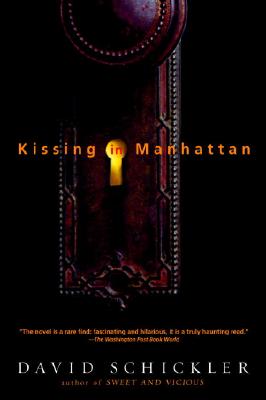 5 August 2003
5 August 2003
Kissing in Manhattan: Stories
David Schickler
It's always a treat when one of Schickler's stories appears in The New Yorker, a welcome reprieve from yet another of John Updike's so-skillfully-crafted-it-could-lull-you-to-sleep ruminations on adulterous upper-middle-class New Englanders. Schickler has a gift for the absurd that reflects everyday life like a funhouse mirror. In this, his first collection of stories, he writes about young urbanites who teeter on the edge of darkness but are rescued by their own pluck and luck and a little bit of goofiness. A mature-beyond-her-years young woman takes her high school teacher by surprise. A lawyer seduces, and uses, the girl he doesn't want but can get, and gets his comeuppance from the girl he really wants. A couple on their honeymoon initiate a secret ritual that sustains their marriage. Every character has a connection to the same fictional apartment building in New York City; if anything, that's what this book is about. It's an old, solid, gorgeous Upper West Side building, the kind they don't make anymore, with flawless plumbing, an intimidating doorman, and a magical elevator.
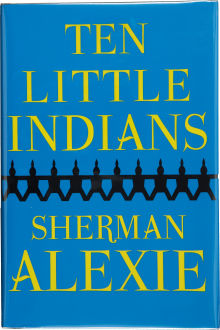 5 August 2003
5 August 2003
Ten Little Indians
Sherman Alexie
Alexie at his best presents a short story like a carefully prepared meal: The first taste is part of the pleasure, the other part is the anticipation of enjoying the rest of it. Sometimes he seems to lose his way, as in the story about a man who uses a sex toy as a talisman to cure his sick child, but I didn't skip any of the nine stories (Why not ten, Sherman? It would be so neat). In each of these stories about present-day American Indians (usually Spokane) he packs his usual one-two punch: The pain of what the white man has done to the Indian will endure for generations, while the Indian, for his part, is often a drunk and a scammer. Alexie can be funny and tender, and is never dull.
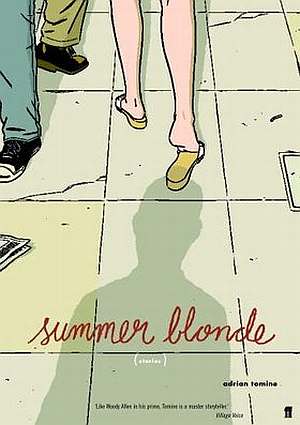 2 June 2003
2 June 2003
Summer Blonde
Adrian Tomine
If, when you think "comics," you think of Bazooka Joe, check out Adrian Tomine. In this collection of four pieces first published in his Optic Nerve comic book series, each story is as emotionally messy as the drawings are clean and precise. Tomine specializes in the internal lives of the socially maladroit, usually teenagers simultaneously disgusted and fascinated by the popular crowd and the adults they grow into: people who suspect that they aren't as happy as everyone else because they're too smart, but who are still resentful about it. His endings never tie up neatly and his characters are ambiguous, often lacking in good judgment, sometimes cruel, yet usually sympathetic; that is, not one is a cartoon figure.
More graphic fiction: Blankets
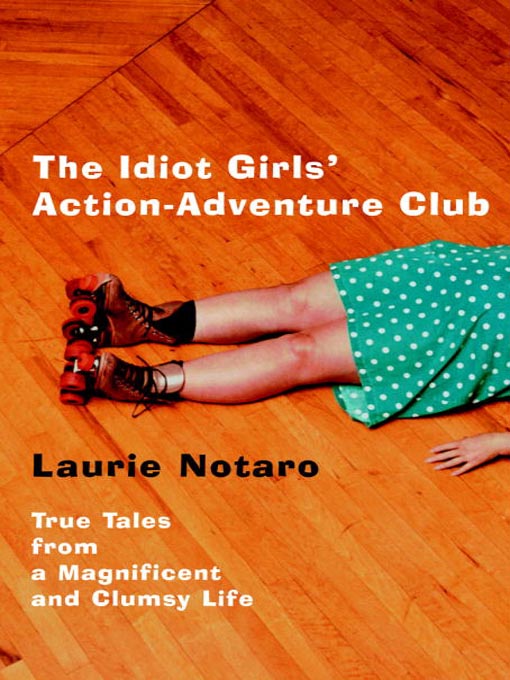 2 June 2003
2 June 2003
The Idiot Girls' Action Adventure Club: True Tales from a Magnificent and Clumsy Life
Laurie Notaro
The recent popularity of Bridget Jones and her many imitators has shown that women can be funny and make fools of themselves, which I think is progress. But let's face it, their adventures are pretty tame, their preoccupations with their looks and marriage a little tiresome. Enter Laurie Notaro, like a breath of stale bar air. She slobbers in her sleep and forgets to wear deodorant. She gets drunk and hits on the wrong gender. When she arrives for jury duty she's mistaken for a homeless person. So she won't have to live with her parents, she applies for a job and is interviewed by a man whom she kicked in the shins when she thought he was trying to steal her Jack Daniels. The truly wild stuff will probably always be left to the boys. But she made me laugh, as she did in her second book, Autobiography of a Fat Bride. It's a little mellower, as she has a marriage and a mortgage, but still a good time.
Also funny: Hypocrite in a Pouffy White Dress
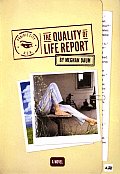 2 June 2003
2 June 2003
The Quality of Life Report
Meghan Daum
The pleasure of a novel usually lies in its extended character development, rumination on detail, and exploration of great themes. In that sense, this is no novel, yet it has pleasures of its own. Lucinda Trout is Smith-educated and in her late twenties, suffering the indignity of barely making ends meet reporting on thongs for a morning television show in New York City. When she is sent to a small Midwestern city to interview methamphetamine addicts, she decides to act on the hunch that most New Yorkers have—that there's a Better Life, and there are Real People, in the Heartland—and gets her employer to finance her “quality of life reports” as she spends a year paying three-figure rent and breathing clean air in Prairie City. Trouble ensues, but it's not the plot that's interesting, as Daum's strength is the quick sketch. She skates on the surface of her story, nailing the women's book group and the ponytailed middle-aged television guy in a few deft strokes. It's a bit curious, and a bit disappointing, that a novel that seems to want to grapple with the big issues of what makes life worth living and how to be a good person is ultimately so unreflective. Lucinda never seems to stop and think about what she's doing, but Daum is such a crack social satirist, as shown in her essays, that I didn't mind going along for the ride.
 28 April 2003
28 April 2003
Stiff: The Curious Lives of Human Cadavers
Mary Roach
This one is a little tough to stomach, but only at the beginning. I'm not sure if it got less gory, I got used to it, or I simply developed the good sense to stop trying to read this book while eating rhubarb crisp. Roach is a nervy and playful writer (in fact, she might say "gutsy"), the perfect guide for visits to a university doing a study of corpse decomposition (they lay them out in the sun), a plastic surgery practice session on previously owned heads, and the Swedish developer of an ecological burial project (yes, it's composting, and it's a great idea!). Roach digs up (ahem) bizarre stories of our apparently less squeamish forebears who consumed mummified humans as medicine and were intensely curious about the possibility of post-guillotine consciousness. There are also some especially grisly and, unfortunately, more modern, stories of amateur crucifixions and head transplant attempts (the latter only on animals, although for both
procedures there are live human volunteers at the ready). She also looks at how cadavers teach us, not only in the anatomy lab but also by providing damning evidence that the airline industry could prevent many needless deaths if it were willing to spend, or charge, more for flights. Although this book takes an appropriately scientific view of death, Roach offers an interesting look at what a dead body is: not at all the person it once was, yet still something human, deserving of respect, and a reminder of our own mortality. Surgeons who pick up beating human hearts in their hands and place them in living bodies and analysts who study bodies in airplane wreckage for clues to the cause of a crash both need to desensitize themselves to what they are doing. I would be honored to have my body put to such good use; I won't be needing it anymore, so why not take the opportunity to do some good after I'm gone? It's not as if the popular alternative, underground decomposition, is a pretty thing to contemplate. The best thing you can do, of course, is donate your organs: please, talk to your family and check that box on your driver's license today or visit organdonor.gov. And read this book.
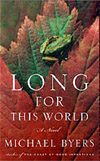 22 April 2003
22 April 2003
Long For This World
Michael Byers
Byers' first novel is set in the Pacific Northwest at the end of the twentieth century—at the edge of the continent and on the brink of the future. Henry Moss is a geneticist specializing in an extremely rare disease that causes children to age rapidly and die as physically old people while still in their early teens (much like what we call progeria). Moss discovers a young man who carries the gene for the disease and yet, remarkably, is not only healthy but preternaturally so. There are shades of Tuck Everlasting in this story, a bit of fantasy running through a very modern domestic novel of family and neighborhood. A couple of disappointments: the drama promised in the first half wasn't sustained in the second, and Byers' attempts at capturing up-to-the-minute speech can feel as cheap and ephemeral as mentions of brand names. His ear for teenage slang sounds accurate to me, which probably means it isn't. But his understanding of his characters is real, and his novel burrows into the heart even as it pulses like a science fiction thriller.
Also about an unusual physical condition: The Girls
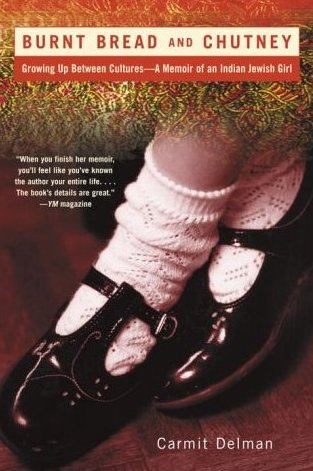 22 April 2003
22 April 2003
Burnt Bread and Chutney: Growing Up Between Cultures—A Memoir of an Indian Jewish Childhood
Carmit Delman
Delman's mother, an Indian Jew, and her father, an American Ashkenazi, met on a kibbutz in Israel and passed onto their four children their love for Judaism and its homeland.
As a teenager, Delman discovers a diary kept by an older female maternal relative who lived with Delman's family throughout her childhood, and learns a family secret.
She weaves excerpts from the diary into her own story of being a bit of a misfit: feeling different from the other girls at Indian dance class;
subjected to ignorance when her family's diet, income, skin color, and Jewish observance caused them to stand out at synagogue; chafing at male-dominated Indian traditions at home;
and, at school, suffering the humiliation, so peculiar to and so strong at that age, of not being able to afford brand-name soda. As an adult,
she can appreciate and pay tribute to the Judaism her parents gave her: "...for years, the slur Jewish American Princess did not even click in my understanding. To me, being Jewish meant rolling up your sleeves. A rugged sort of living and healthy minimalism. It was closely connected to a peasant life." Delman's eye for recollected detail, her quiet, dry wit, and her merciless yet wholly endearing self-scrutiny mark her as a talent to watch.
More on living between two cultures: Turbulent Souls
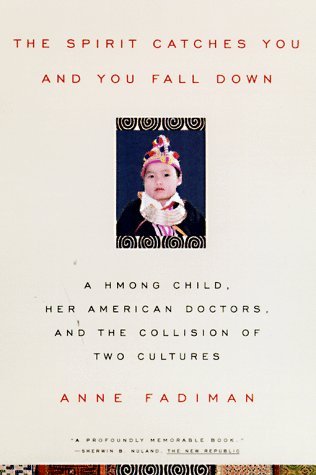 22 April 2003
22 April 2003
The Spirit Catches You And You Fall Down:
A Hmong Child, Her American Doctors, and the Collision of Two Cultures
Anne Fadiman
Lia Lee is youngest and favorite of eight children in a Hmong family newly settled in Merced, California. When, as a cherubic toddler, she begins to have epileptic seizures, her parents take her to the nearby county hospital, beginning a medical odyssey shaped by the conflict between Western and Hmong cultures. Fadiman is a fair yet compassionate observer of the clash in world views between Lia's parents, who believe that Lia's suffering is caused by the departure of her soul and will be cured by animal sacrifices, and Lia's frustrated doctors, who insist on prescribing medications that her parents won't give her, in languages that her parents don't understand. Fadiman broadens her story to look at the whole Hmong community: how the Hmong were used by the US military in the Vietnam war, suffered a terrifying flight on foot from Laos, and immigrated to the United States, only to be abused by Americans mistaking them for Vietnamese. The Hmong are often resented by the Western doctors who toil for little or no pay to provide them with medical care and are rewarded only by greater demands and complaints from the Hmong, who generally believe, and not always without cause, that it is medical treatment that causes illness. It's a remarkable portrait of the coexistence, and sometimes collision, of two worlds with seemingly no common ground, a reminder of how similar people all over the world are, and yet how very different.
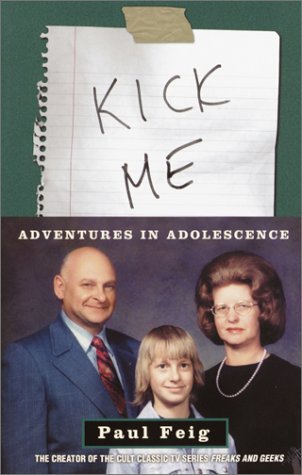 22 April 2003
22 April 2003
Kick Me: Adventures in Adolescence
Paul Feig
There's nothing like a funny book to make a commute go quickly. If I could read this book fresh every day I wouldn't mind standing for an hour under a drainpipe as four subway trains passed me by. Feig is the creator of Freaks and Geeks, a show on TV or cable or whatever it's called these days. He offers up his own cringe-inducing, outrageous high school experience as gym class pariah and pint-sized neurotic without a trace of shame or self-pity, and his observations are touching in unexpected ways. His puppy love for a fellow student turns into a nightmare date and he ends the evening watching old comedy shows with his dad, nostalgic for childhood as only those who are being hustled out its door can be. Morning commuters are advised to wait until breakfast has completely settled before attempting the ResusciAnnie chapter, but otherwise this book is a perfect anesthetic.
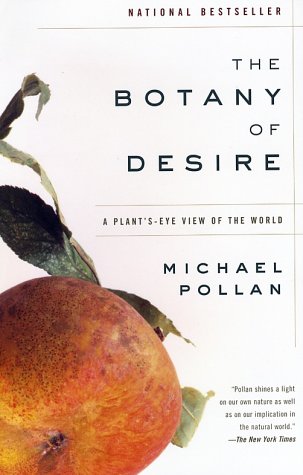 22 April 2003
22 April 2003
The Botany of Desire: A Plant's-Eye View of the World
Michael Pollan
Pollan has a lovely, soothing tone that says to the reader, “Sit back, while I explain the world to you.” His main idea is simple: Plants are using us just as much as we are using them ("using" being a term of convenience; we are all subjects of evolutionary natural selection). It's in many a plant's best interest to please us, as that means we'll help it make more of itself, which is every organism's goal. Pollan looks at four plants that are grown by people: apples, tulips, marijuana, and potatoes; a section for each includes anecdotes, history, personal experience, and a little bit of science. Makes you think twice about your seat at the top of the food chain.
 5 March 2003
5 March 2003
Jews Without Judaism: Conversations with an Unconventional Rabbi
Daniel Friedman
A concise, easy to read summary of the Secular Humanist Jewish perspective, according to one man, anyway. A refreshing option for Jews who are committed to their people and ethics, but who reject the idea of God. Friedman makes a strong case for why Jews shouldn't fear death—or even intermarriage—and he praises the special gift that Judaism brings to the world. His theses—that, for most modern-day Jews, Judaism is a wholly secular, rather than religious practice; that anti-Semitism is largely a thing of the past; and that change should be embraced rather than feared—may make some uneasy. For others, they are welcome and inspiring.
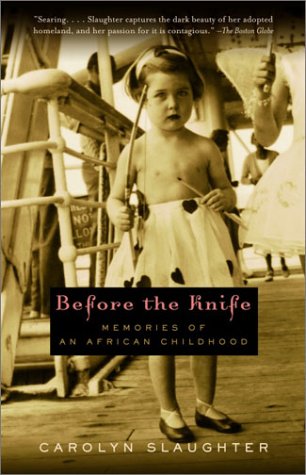 5 March 2003
5 March 2003
Before the Knife: Memories of an African Childhood
Carolyn Slaughter
Slaughter's memoir recalls her life as a white child in the 1950s in what is now Botswana, living with her violent and tyrannical father and her physically present but otherwise absent mother. She has a passionate connection to the wild African landscape, beautifully rendered here, yet her young life is miserable. She finds relief when sent to live with an Afrikaner family for a summer, and finally escapes for good, but not before coming to a terrifying confrontation with her father. Her book is mostly about herself and her family, though she is sharply aware of the growing independence movement that sets Africa simmering under the ever-shakier lid of the colonial presence. And it's hard to believe that her parents' unhappiness and cruelty at home is separable from their self-imposed exile in a land where they aren't wanted.
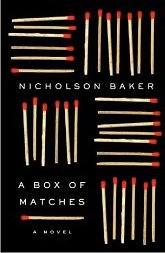 5 March 2003
5 March 2003
A Box of Matches
Nicholson Baker
Alas, picking up the new Nicholson Baker book is like meeting an old friend for coffee and realizing you no longer have anything in common. I know I wasn't the only one who developed a huge crush on Baker with the 1988 publication of The Mezzanine, a journey through the trivial corners of one man's mind as he makes a trip to the mall to buy shoelaces. To this day, every time I'm in a drug store I think of his maxim about choosing not the line that's shortest but the one with the smartest cashier. I really thought things were going somewhere between us when he came out with Room Temperature, a valentine to marriage and new parenthood. The Updike obsession (U & I) I could live with, but then he took a detour into phone sex (Vox) and voyeurism (Fermata) and my ardor cooled. When I saw him speak recently at the library about Double Fold, his righteous crusade against the destruction of old newspapers, I realized I missed his fussy obsession with detail. Seeing writers in person is usually frustrating. When you have unfettered access to a man's innermost musings, you expect some kind of connection in person, when in fact writers are probably shyer than average and less able to connect. Baker was no exception. But I thought we might be able to rekindle the flame with A Box of Matches. In this new novel, a man in his mid-forties with a wife and two kids begins a routine of waking up at four in the morning to build a fire in the dark and think typically Bakerian thoughts about holes in his socks. More pedestrian minds might diagnose this as clinical depression, others call it literature. It may well be that Baker is a victim of his own success—what was once original has been imitated to death—but, whatever the reason, I found minutiae for its own sake tiresome. Emblematic is the scene where the main character lies beside his sleeping wife, listening to a faint, high, keening wail. Is it a prowling cat? A lost child? Should he wake his wife? Call the police? Then he realizes: the sound is coming from inside of his own nose.
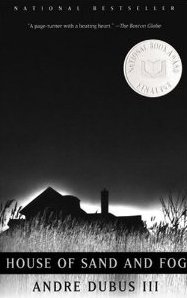 6 February 2003
6 February 2003
House of Sand and Fog
Andre Dubus III
A young woman, left by her husband and turning to drugs, botches her mortgage payments and has her house foreclosed on her. It's sold for a song to a family from Iran, a former colonel now forced to do highway clean-up work to feed his wife and son. One could make a case for either party's claim to the house, and when the local sheriff gets mixed up in the case, and with the woman, and begins to self-destruct, the conflict quickly turns ugly. Tragedy is inevitable in this superb example of a character-driven plot.
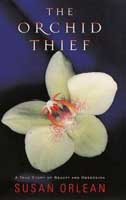 30 January 2003
30 January 2003
The Orchid Thief: A True Story of Beauty and Obsession
Susan Orlean
For four years this book hovered at the edge of my radar. Orchids? Yawn. Oddly enough, there is a large subculture of people who are absolutely obsessed with them. Orlean's book is a New Yorker profile hothoused into a full-length work, slim and repetitive but packed with quirky characters and bizarre trivia. I picked it up because Adaptation, the movie about writing the screenplay for the book, intrigued me, being the latest offering from the director of the enthrallingly freakish Being John Malkovich, and I thought the way to get the most out of the film was to have just read the book. The Orchid Thief is one of the last books that would seem to lend itself to a movie, as it has no plot and is mostly anecdotes about dirty real estate schemes and monomaniacal botanical explorers, but Orlean's prose is lush and sweet-smelling and makes the white pages glow with the green of the Everglades. As with any good book, what I really wanted was to not stop reading it, to step into it, and now I had that very opportunity. What's more, since the movie is about making the book into a movie, it's basically a continuation of the reading process. I tried to time it so that the transition would be seamless; ideally I would finish the book on the subway ride to the theater. I couldn't put the book down and ended up reading it in one afternoon, but three days later I saw the film and I can't imagine what I would have made of it if I hadn't read the book. Adaptation not only doesn't have a plot, it doesn't have any content. Nicolas Cage does a terrific job of playing dissimilar identical twins and there are a few laughs and a couple of vague ideas, but it's also upsetting in parts to no particular end. And in that, I imagine the scriptwriter would say, it's kind of like life.
More about obsession: Confederates in the Attic
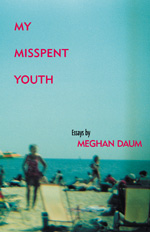 15 January 2003
15 January 2003
My Misspent Youth
Meghan Daum
Daum's work has been compared to a hot fudge sundae. This collection of personal essays doesn't take her beyond the world of any smart young adult in Manhattan (she later moved to Nebraska and wrote an autobiographical novel); she writes about polyamorous relationships, crushes on Jewish boys, e-mail courtship, and money worries. Her main subject is herself, but even in her self-indulgent moments she's smart enough to be critically observant.
"There was so much to read, for one thing, and so much fine health to be pulled down out of the young breathgiving air...I was rather literary in college—one year I wrote a series of very solemn and obvious editorials for the Yale News—and now I was going to bring back all such things into my life and become again that most limited of all specialists, the 'well-rounded man.' This isn't just an epigram—life is much more successfully looked at from a single window, after all."—F. Scott Fitzgerald, The Great Gatsby
Copyright © 1996–2025 So Much to Read
Contact: books at so much to read dot com